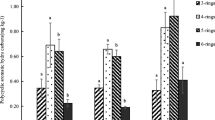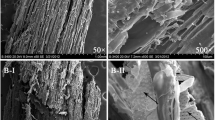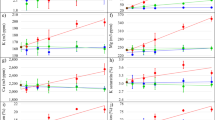Abstract
Hyperthermophilic pretreatment (80 °C, 24 h) is a technology that promotes methane yield in the anaerobic digestion of sewage sludge. However, little information is available on the characteristics of sludge anaerobically digested with hyperthermophilic pretreatment as a fertilizer and on the environmental impact of using the sludge as a fertilizer. In this study, we conducted incubation experiments to examine the characteristics of methane production and nitrogen mineralization in paddy soil treated with sludge from anaerobic digestion that was enhanced by hyperthermophilic pretreatment. Sludge samples digested under 15, 25, 30 and 35 °C with and without hyperthermophilic pretreatment were used. Sixty-mL vials were used in the experiment. Each vial was filled with 5 g of air-dried paddy soil, 10 mL of degassed water and digested sludge. It was then covered with a butyl rubber stopper, its headspace air was replaced by N2, and it was incubated at 30 °C. Methane concentrations in the headspace of the vials were measured after 7, 14, 28, 46, 57, 70 and 84 days. NH4-N concentrations in the soil were also measured after 0, 14, 28 and 84 days. The results indicated that relatively more methane tended to be produced in soil treated with sludge from anaerobic digestion that was enhanced by hyperthermophilic pretreatment than in non-pretreated sludge. On the other hand, a small amount of NH4-N was released from sludge digested with hyperthermophilic pretreatment at all digestion temperatures because organic nitrogen had been decomposed under hyperthermophilic pretreatment. Therefore, the appropriate application rate of sludge digested with hyperthermophilic pretreatment can be determined based on NH4-N in digested sludge without consideration of nitrogen mineralized after application when the sludge is used as a fertilizer.







Similar content being viewed by others
References
ADAS UK Ltd, SAC Commercial Ltd (2007) Nutrient value of digestate from farm-based biogas plants in Scotland. https://www2.gov.scot/resource/doc/1057/0053041.pdf. Accessed 21 Dec 2018
Golueke CG (1977) Biological reclamation of solid wastes. Rodale Press, Emmaus
Hidaka T, Takabe Y, Tsumori J, Yamamoto-Ikemoto R, Togari T (2015) Sewage sludge recycling and high-solids anaerobic co-digestion for small scale wastewater treatment plants. J Jpn Inst Energy 94(7):705–714 (in Japanese)
IEA Bioenergy (2010) Utilization of digestate from biogas plants as biofertilizer. http://www.iea-biogas.net/files/daten-redaktion/download/publi-task37/Digestate_Brochure_Revised_12-2010.pdf. Accessed 21 Dec 2018
IPCC (2006) Volume 4. Agriculture, forestry and other land use: 2006 IPCC Guidelines for National Greenhouse Gas Inventories
Lay J, Li Y, Noike T (1996) Effect of moisture content and chemical nature on methane fermentation characteristics of municipal solid wastes. J Environ Syst Eng JSCE 7:101–108
Lee M, Hidaka T, Tsuno H (2008) Effect of temperature on performance and microbial diversity in hyperthermophilic digester system fed with kitchen garbage. Biores Technol 99:6852–6860
Lee M, Hidaka T, Hagiwara W, Tsuno H (2009) Comparative performance and microbial diversity of hyperthermophilic and thermophilic co-digestion of kitchen garbage and excess sludge. Biores Technol 100:578–585
Li Y, Noike T (1989) The effect of thermal pretreatment and retention time on the degradation of waste activated sludge in anaerobic digestion. Jpn J Water Pollut Res 12(2):112–121 (in Japanese)
Ministry of Agriculture, Forestry and Fishery (2016) Basic plan for promoting biomass utilization (in Japanese)
Möller K, Müller K (2012) Effects of anaerobic digestion on digestate nutrient availability and crop growth: a review. Eng Life Sci 12(3):242–257
Nagumo Y, Oyanagi A, Murakami K, Tanahashi T, Kato S, Ando T, Tsuchida T, Kato N (2011) Estimate of methane emission potential of poultry manure compost and swine manure compost from amount of acid detergent soluble organism. Jpn J Soil Sci Plant Nutr 82(5):401–404 (in Japanese)
Nakamura M, Yamaoka M, Oritate F (2017) Influence of application of methane fermentation digested slurry on methane production in paddy soil by incubation experiment. Jpn J Soil Sci Plant Nutr 88(1):38–41 (in Japanese)
Nakamura M, Hidaka T, Yamaoka M, Oritate F (2018) Methane production and nitrogen mineralization in paddy soil treated with low-temperature anaerobically digested sludge. Irrig Drain Rural Eng J 86(2):139–146 (in Japanese)
NEDO (2017) Technical guideline and requirements for introducing self-sustaining regional biomass energy system (in Japanese)
Nopharatana A, Pullammanappalli PC, Clarke WP (2007) Kinetics and dynamic modelling of batch anaerobic digestion of municipal solid waste in a stirred reactor. Waste Manage 27(5):595–603
The Japanese Standards Association (2007) Testing methods for industrial wastewater, pp. 260–266 (in Japanese)
United Nations (2017) Sustainable development goals. https://www.un.org/sustainabledevelopment/. Accessed 19 Dec 2018
Wang F, Hidaka T, Tsumori J (2014) Enhancement of anaerobic digestion of shredded grass by co-digestion with sewage sludge and hyperthermophilic pretreatment. Biores Technol 169:299–306
Watanabe A, Katoh K, Kimura M (1993) Effect of rice straw application on CH4 emission from paddy fields, II contribution of organic constituents in rice straw. Soil Sci Plant Nutr 39(4):707–712
Acknowledgements
This work was supported by the Osaka Bay Regional Offshore Environmental Improvement Center and JSPS KAKENHI Grant Number JP17K18349. We would also like to express our gratitude to the WWTP for providing sludge for this study.
Author information
Authors and Affiliations
Corresponding author
Rights and permissions
About this article
Cite this article
Nakamura, M., Hidaka, T., Yamaoka, M. et al. Methane production and nitrogen mineralization in paddy soil treated with sludge from anaerobic digestion enhanced by hyperthermophilic pretreatment. Paddy Water Environ 17, 447–454 (2019). https://doi.org/10.1007/s10333-019-00740-3
Received:
Revised:
Accepted:
Published:
Issue Date:
DOI: https://doi.org/10.1007/s10333-019-00740-3




